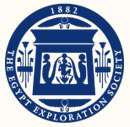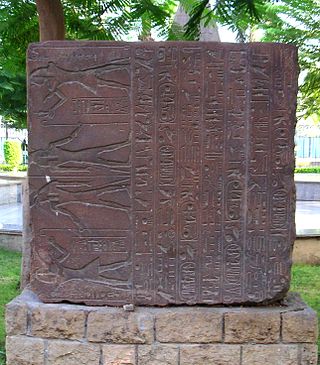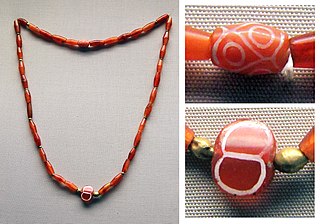
Weaving is a method of textile production in which two distinct sets of yarns or threads are interlaced at right angles to form a fabric or cloth. Other methods are knitting, crocheting, felting, and braiding or plaiting. The longitudinal threads are called the warp and the lateral threads are the weft, woof, or filling. The method in which these threads are interwoven affects the characteristics of the cloth. Cloth is usually woven on a loom, a device that holds the warp threads in place while filling threads are woven through them. A fabric band that meets this definition of cloth can also be made using other methods, including tablet weaving, back strap loom, or other techniques that can be done without looms.

Linen is a textile made from the fibers of the flax plant.

A mastaba, also mastabah, mastabat or pr-Djt, is a type of ancient Egyptian tomb in the form of a flat-roofed, rectangular structure with inward sloping sides, constructed out of mudbricks or limestone. These edifices marked the burial sites of many eminent Egyptians during Egypt's Early Dynastic Period and Old Kingdom. In the Old Kingdom epoch, local kings began to be buried in pyramids instead of in mastabas, although non-royal use of mastabas continued for over a thousand years. Egyptologists call these tombs mastaba, from the Arabic word مصطبة (maṣṭaba) "stone bench".

The Egypt Exploration Society (EES) is a British non-profit organization. The society was founded in 1882 by Amelia Edwards and Reginald Stuart Poole in order to examine and excavate in the areas of Egypt and Sudan. The intent was to study and analyze the results of the excavations and publish the information for the scholarly world.

Tablet weaving is a weaving technique where tablets or cards are used to create the shed through which the weft is passed. As the materials and tools are relatively cheap and easy to obtain, tablet weaving is popular with hobbyist weavers. Most tablet weavers produce narrow work such as belts, straps, or garment trims.

Fustian is a variety of heavy cloth woven from cotton, chiefly prepared for menswear. It is also used figuratively to refer to pompous, inflated or pretentious writing or speech, from at least the time of Shakespeare. This literary use is because the cloth type was often used as padding, hence, the purposeless words are fustian.

The Petrie Museum of Egyptian Archaeology in London is part of University College London Museums and Collections. The museum contains 80,000 objects, making it one of the world's largest collections of Egyptian and Sudanese material. It is designated under the Arts Council England Designation Scheme as being of "national and international importance".

Athribis was an ancient city in Lower Egypt. It is located in present-day Tell Atrib, just northeast of Benha on the hill of Kom Sidi Yusuf. The town lies around 40 km north of Cairo, on the eastern bank of the Damietta branch of the Nile. It was mainly occupied during the Ptolemaic, Roman, and Byzantine eras.

El Lahun. It was known as Ptolemais Hormos in Ptolemaic Egypt.

Meidum, Maydum or Maidum is an archaeological site in Lower Egypt. It contains a large pyramid and several mudbrick mastabas. The pyramid was Egypt's first straight-sided one, but it partially collapsed in ancient times. The area is located around 72 kilometres (45 mi) south of modern Cairo.

John Garstang was a British archaeologist of the Ancient Near East, especially Egypt, Sudan, Anatolia and the southern Levant. He was the younger brother of Professor Walter Garstang, FRS, a marine biologist and zoologist. Garstang is considered a pioneer in the development of scientific practices in archaeology as he kept detailed records of his excavations with extensive photographic records, which was a comparatively rare practice in early 20th-century archaeology.
The study of the history of clothing and textiles traces the development, use, and availability of clothing and textiles over human history. Clothing and textiles reflect the materials and technologies available in different civilizations at different times. The variety and distribution of clothing and textiles within a society reveal social customs and culture.

Tarkhan is an ancient Egyptian necropolis, located around 50 km south of Cairo on the west bank of the Nile. The cemetery was excavated in two seasons by Flinders Petrie. Tombs of almost all periods were found, but most importantly many belonging to the time of Egyptian state formation, the Early Dynastic period around 3100 BC. Petrie found more than 2,000 tombs, most of them simple holes in the ground belonging to common people. However, there were also several mastabas of the First Dynasty, decorated with a palace facade.

Grace Mary Crowfoot was a British archaeologist and a pioneer in the study of archaeological textiles. During a long and active life Molly—as she was always known to friends, family and close colleagues—worked on a wide variety of textiles from North Africa, the Middle East, Europe and the British Isles. Returning to England in the mid-1930s after more than three decades spent in Egypt, Sudan and Palestine, Crowfoot co-authored a 1942 article on the "Tunic of Tutankhamun" and published short reports about textiles from the nearby Anglo-Saxon ship burial at Sutton Hoo (1951-1952) in Suffolk.
Violette Lafleur was a Canadian conservator and curator for the Department of Egyptology and Petrie Museum of Egyptian Archaeology, University College London.
Elise Jenny Baumgartel was a German Egyptologist and prehistorian who pioneered the study of the archaeology of predynastic Egypt.
Alice Stevenson is a British archaeologist and museum curator. She is Professor of Museum Archaeology at UCL's Institute of Archaeology and a specialist in Predynastic and Early Dynastic Egyptian archaeology.

Etched carnelian beads, or sometimes bleached carnelian beads, are a type of ancient decorative beads made from carnelian with an etched design in white, which were probably manufactured by the Indus Valley civilization during the 3rd millennium BCE. They were made according to a technique of alkaline-etching developed by the Harappans, and vast quantities of these beads were found in the archaeological sites of the Indus Valley civilization. They are considered as an important marker of ancient trade between the Indus Valley, Mesopotamia and even Ancient Egypt, as these precious and unique manufactured items circulated in great numbers between these geographical areas during the 3rd millennium BCE, and have been found in numerous tomb deposits.
Pleated linen is a form of processing linen which results in a fabric which is heavily pleated and does not crease like normal linen fabric.

Nyibunesu, Ni-Ibunesut or Ne-Ibunesu was an ancient Egyptian priest of Hathor and local chief who lived during the Third or Fourth Dynasty in the region of Dendera. What is known from his life comes from his mastaba burial tomb in the Dendera Necropolis, a few hundred metres south of the Temple to Hathor. This tomb was explored during 1897 and 1898 by a team led by the British archaeologist Flinders Petrie.
















